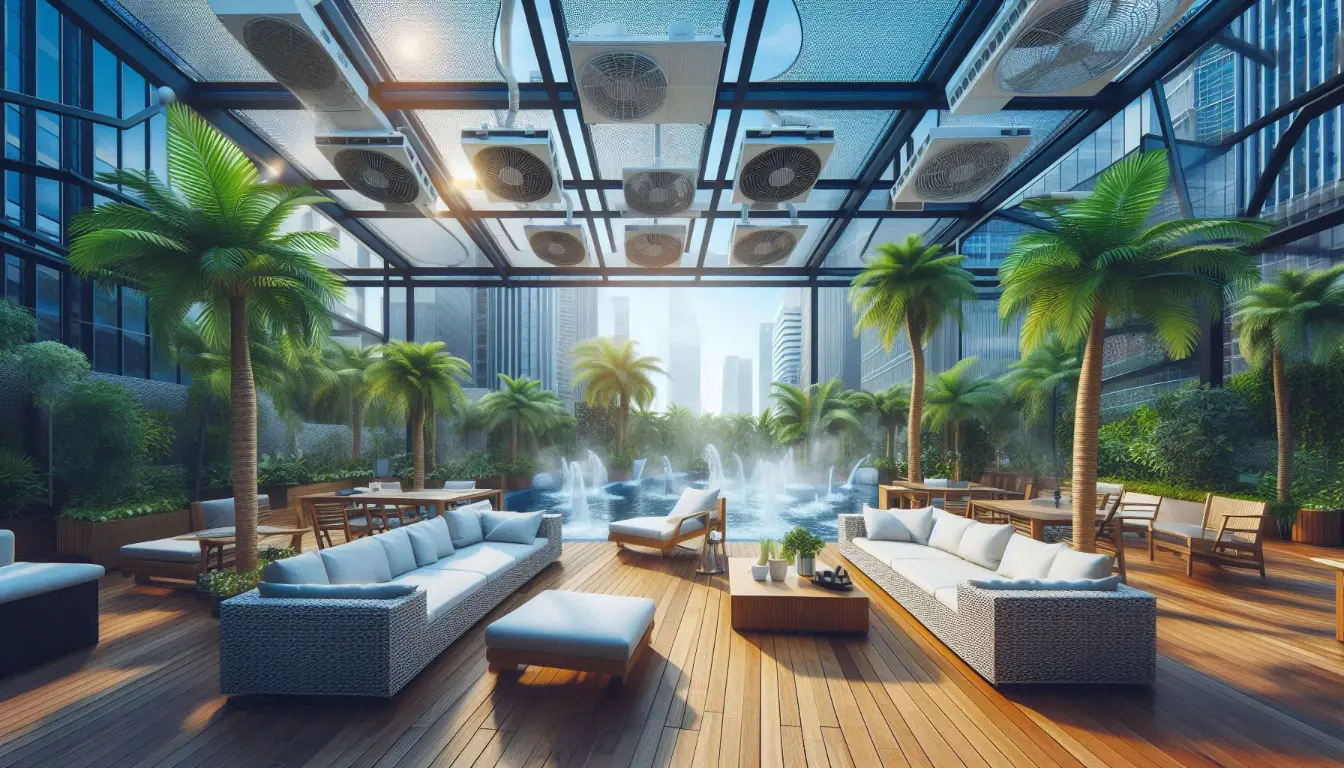Did you know that by 2050, the energy used for cooling could triple, gobbling up as much electricity as all of China and India use today? That’s a lot of power! As our summers get hotter and we look for ways to stay cool outdoors, it’s super important to think about how our cooling choices affect the planet.
In this guide, we’ll explore the eco-footprint of different outdoor cooling methods, from energy-hungry air conditioners to greener options. We’ll help you figure out how to stay comfy without heating up the Earth. Whether you’re a homeowner, business owner, or just someone who cares about the environment, understanding the impact of outdoor cooling is the first step to making smart, Earth-friendly choices.
Key Takeaways
Learn how much energy different cooling methods use and what that means for the planet
Discover how water-based cooling systems affect our water resources
Understand the environmental concerns about refrigerants used in some cooling tech
Explore eco-friendly alternatives and best practices for green outdoor cooling
Get a sneak peek at future cooling technologies that could help save the planet
The Energy Equation: Powering Our Cool Obsession
One of the biggest environmental concerns with outdoor cooling is how much energy it uses. Different cooling methods need different amounts of power, which can lead to more carbon emissions if the energy comes from fossil fuels.
Comparing Energy Use Across Cooling Methods
| Cooling Method | Energy Use (kWh/day) | CO2 Emissions (kg/day) |
| Central AC | 30-60 | 15-30 |
| Portable AC | 8-15 | 4-7.5 |
| Evaporative Cooler | 2-7 | 1-3.5 |
| Misting System | 1-3 | 0.5-1.5 |
| Ceiling Fan | 0.5-1 | 0.25-0.5 |
Note: These numbers can vary based on the specific model, how you use it, and where your electricity comes from.
The Power of Green Energy
Using renewable energy sources can really help reduce the environmental impact of outdoor cooling:
Solar-powered cooling: Using the sun’s energy to run cooling devices
Wind energy: Using wind turbines to generate electricity for cooling
Geothermal cooling: Using the Earth’s steady underground temperatures
A solar-powered outdoor cooling system, combining sustainability with comfort
Water Wisdom: The Hidden Cost of Evaporative Cooling
While evaporative cooling methods like misting systems and swamp coolers are often praised for using less energy, they do use water – which can be a problem in areas where water is scarce.
How Much Water Do These Systems Use?
A typical home misting system might use 1-2 gallons of water per hour
Big commercial systems can use up to 40 gallons per hour
Evaporative coolers can use 3-15 gallons of water per day
In places where water is already limited, this extra use can put more stress on water supplies.
Smart Ways to Save Water
Use high-efficiency nozzles in misting systems
Set up water recycling systems
Collect and use rainwater for cooling
Adjust when you use cooling to waste less water
The Refrigerant Riddle: A Cooling Catch-22
Many traditional cooling systems use refrigerants, some of which can be really bad for the environment if they leak into the air.
Environmental Impact of Common Refrigerants
Chlorofluorocarbons (CFCs): These are banned because they damage the ozone layer
Hydrochlorofluorocarbons (HCFCs): Being phased out, less harmful than CFCs but still not great
Hydrofluorocarbons (HFCs): Don’t hurt the ozone layer but can contribute to global warming
The Hunt for Green Alternatives
Natural refrigerants like ammonia, CO2, and hydrocarbons
Development of new synthetic refrigerants that are better for the environment
Exploring cooling technologies that don’t use vapor compression
Eco-friendly refrigerants are part of the solution for greener cooling
Biodiversity and Local Ecosystems: The Bigger Picture
The environmental impact of outdoor cooling goes beyond just energy and water use. These systems can also affect the plants and animals around us.
Potential Ecological Impacts
Noise from cooling equipment can disturb wildlife
Misting systems might change local humidity levels and affect plants
Heat from AC units can create “heat islands” in urban areas
Ways to Minimize Ecological Effects
Use quiet cooling equipment to avoid disturbing animals
Design cooling systems to have less impact on nearby plants
Use green infrastructure like shade trees and green roofs to cool naturally
The Path to Sustainable Cooling: Best Practices and Cool Innovations
As more people become aware of environmental issues, there’s a growing push for more sustainable cooling solutions. Here are some best practices and innovations leading the way:
Passive cooling design: Using natural airflow and shade in building design
Smart cooling systems: Using AI and the Internet of Things to optimize cooling efficiency
District cooling: Centralized cooling systems that serve multiple buildings, improving overall efficiency
Phase change materials: Special substances that absorb and release heat as they change state, providing cooling without using energy
Green infrastructure like shade trees and living walls provide natural cooling
Conclusion: Balancing Comfort and Conservation
As we face the dual challenges of rising temperatures and environmental concerns, finding sustainable ways to keep cool outdoors is more important than ever. By understanding the environmental impact of different cooling methods, we can make informed choices that balance our need for comfort with our responsibility to the planet.
Remember:
Choose cooling solutions that fit your climate and needs
Prioritize energy-efficient and water-wise options
Think about the full lifecycle impact of cooling systems, including refrigerant use
Integrate natural cooling methods wherever possible
Stay informed about new green cooling technologies
By making smart choices about how we cool our outdoor spaces, we can enjoy the comfort of a cool breeze without turning up the heat on our planet. Let’s work together to create a cooler, greener future for all!
Ready to make your outdoor cooling more eco-friendly? Consult with a sustainable cooling expert to explore green options for your space. Stay cool and stay green!

![7 Surprising Outdoor Cooling Solutions: Ultimate Guide [2024]](https://cdn.grigora.co/projects/9ddcd5c8-c62c-4197-a4a5-98dcb51b83a4/images/2025/9/15/fountain-bellcote-fireboatwhite01q0al.webp)
